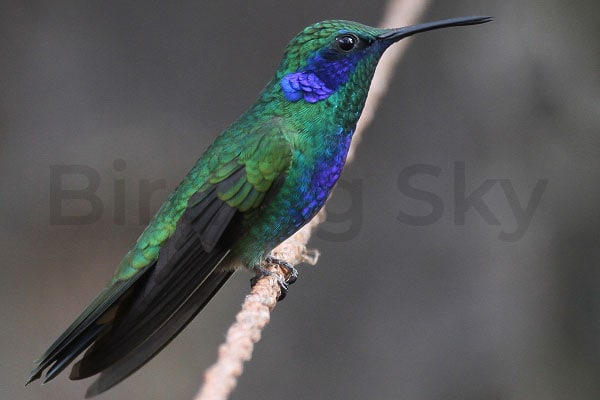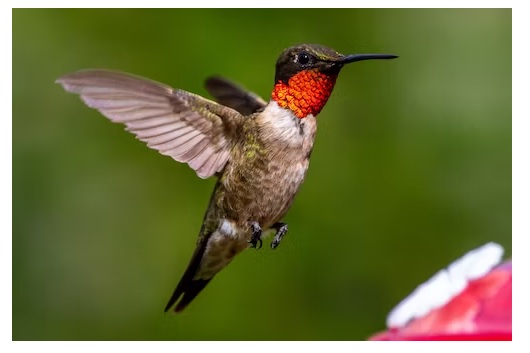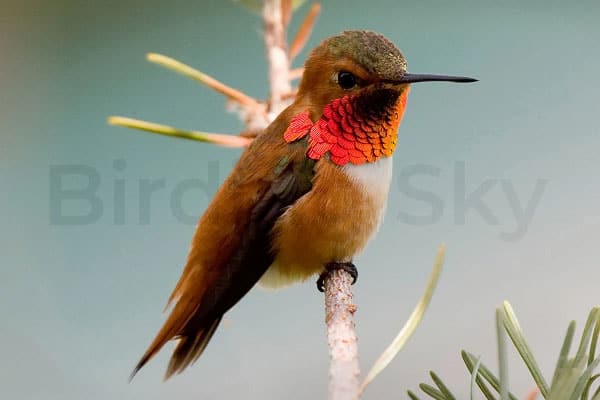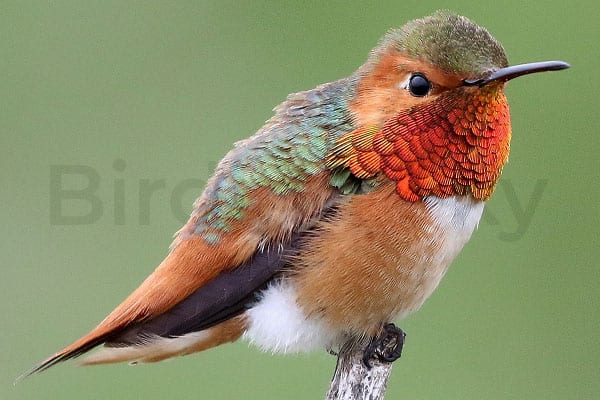Prepare to be amazed as we take you on a visual and auditory journey into the world of hummingbirds in Wisconsin. These tiny wonders bring a burst of color and melody to our gardens and natural landscapes. Get ready to discover the breathtaking beauty and unique characteristics of six hummingbird species through stunning visuals and audio guides.
Key Takeaways:
- Wisconsin is home to six different species of hummingbirds.
- We will explore each species through pictures and sound.
- Discover the unique characteristics and behaviors of these tiny wonders.
- Learn how to create an inviting habitat for hummingbirds in your garden.
- Explore the best locations in Wisconsin for hummingbird watching.
1. Allen’s Hummingbird (Selasphorus sasin)
The Allen’s Hummingbird, scientifically known as Selasphorus sasin, is one of the hummingbird species found in Wisconsin. This stunning bird is known for its distinctive characteristics, habitat preferences, and fascinating behavior.
During breeding season, the male Allen’s Hummingbird performs elaborate courtship displays to attract females. These displays include the iconic “dive display,” where the male climbs to a great height and plummets towards the ground, producing a distinct whirring sound with its wings.
This hummingbird species is also known for its long-distance migration. Some individuals travel from breeding grounds in coastal California to wintering grounds in Mexico, covering thousands of miles. Migration patterns can vary, with some Allen’s Hummingbirds staying in their breeding territory year-round.
Allen’s Hummingbird vs. other Hummingbird Species in Wisconsin
| Species | Size | Plumage | Migration |
|---|---|---|---|
| Allen’s Hummingbird | Small | Males: Orange-red Females: Green and white |
Long-distance migration |
| Ruby-Throated Hummingbird | Small | Males: Red throat patch Females: Green and white |
Long-distance migration |
| Anna’s Hummingbird | Medium | Males: Iridescent green Females: Grayish with green |
Resident or short-distance migration |
| Broad-Billed Hummingbird | Small | Males: Shimmering blue throat Females: Green and white |
Seasonal migration |
| Green Violetear/Mexican-Violetear | Medium | Green with violet ear patch | Occasional straying |
| Rufous Hummingbird | Small | Males: Orange with reddish throat Females: Green and white |
Long-distance migration |
2. Anna’s Hummingbird (Calypte anna)

When it comes to the hummingbird species found in Wisconsin, the Anna’s Hummingbird (Calypte anna) is definitely a standout. Named after Anna Masséna, Duchess of Rivoli, this species is known for its vibrant colors and fascinating behavior.
If you ever have the chance to spot an Anna’s Hummingbird, you’ll be mesmerized by its stunning appearance. With iridescent green feathers on its back and a vibrant red crown, this little bird is a true gem.
Unlike other hummingbird species, the Anna’s Hummingbird is a year-round resident in some parts of California and the Pacific Northwest. However, it can occasionally stray into Wisconsin during its migration. So keep your eyes peeled!
The Anna’s Hummingbird is known for its impressive flying skills and agility. It can hover in mid-air, fly backwards, and even perform acrobatic aerial displays to attract mates.
Fascinating Facts About the Anna’s Hummingbird:
- Only the male Anna’s Hummingbird has the vibrant red crown. The females have a duller green coloration.
- Their favorite food is nectar from flowers, but they also eat insects and spiders.
- Anna’s Hummingbirds are known for their beautiful and melodic songs, which they use to communicate with other birds.
- These tiny birds have a high metabolism and need to consume half their body weight in nectar every day.
- Anna’s Hummingbirds are superb pollinators and play a crucial role in maintaining the balance of ecosystems.
| Scientific Name | Common Name | Habitat | Conservation Status |
|---|---|---|---|
| Calypte anna | Anna’s Hummingbird | Coastal California and the Pacific Northwest | Least Concern |
If you’re lucky enough to see an Anna’s Hummingbird in Wisconsin, take a moment to appreciate its beauty and marvel at its incredible capabilities. These enchanting creatures bring joy and wonder wherever they go.
3. Broad-billed hummingbird (Cynanthus latirostris)

The Broad-Billed Hummingbird, scientifically known as Cynanthus latirostris, is an extraordinary species that occasionally visits Wisconsin. With its striking appearance and unique migratory patterns, this hummingbird never fails to captivate observers.
“The Broad-Billed Hummingbird is a sight to behold. Its vibrant plumage and elongated bill make it stand out among other hummingbird species.” – Birdwatcher John Thompson
The Broad-Billed Hummingbird gets its name from its broad and slightly curved bill, which is perfectly adapted for feeding on nectar from tubular flowers. Its colorful plumage features a glittering turquoise throat and a bright orange belly that contrasts beautifully against its green back.
This species is mainly found in Mexico and Central America, but during migration, some individuals may make their way to Wisconsin. Their journey takes them across vast distances, crossing deserts, mountains, and bodies of water. It’s truly a remarkable feat for such a tiny bird.
Although the Broad-Billed Hummingbird’s visits to Wisconsin are sporadic, lucky birdwatchers may catch a glimpse of this dazzling creature as it seeks out nectar-rich flowers and defends its territory.
Characteristics of the Broad-Billed Hummingbird:
- Scientific Name: Cynanthus latirostris
- Size: Approximately 3.5 to 4 inches in length
- Weight: Around 0.12 to 0.15 ounces
- Wingspan: Approximately 5 to 6 inches
- Habitat: Woodlands, gardens, and flowering mountain slopes
- Feeding Habits: Consumes nectar from tubular flowers, occasionally eats small insects and spiders
- Breeding: Builds cup-shaped nests made of plant fibers, spider silk, and other soft materials
Observing the Broad-Billed Hummingbird in Wisconsin is a rare and unforgettable experience for any hummingbird enthusiast. Keep your feeders filled with fresh nectar and create a welcoming habitat, and you may be rewarded with a visit from this stunning beauty.
| Migratory Patterns | Preferred Flowers |
|---|---|
| Spring: From southern Mexico to southwestern United States | Agave, Penstemon, Salvia |
| Summer: Breeding in mountainous regions of Mexico | Columbine, Red Yucca, Indian Paintbrush |
| Fall: Migration from Mexico to Central America | Hibiscus, Turk’s Cap, Prickly Pear Cactus |
4. Green Violetear/Mexican-Violetear (Colibri thalassinus)
Colibri thalassinus, commonly referred to as the Green Violetear or Mexican-Violetear, is a stunning hummingbird species that occasionally strays into Wisconsin. With its striking colors and unique behavior, this bird is a delight to observe.
The Green Violetear is known for its iridescent green feathers, which shimmer in the sunlight. Its name comes from the violetear-shaped patch of violet feathers behind its eyes. This distinctive feature adds to the bird’s charm and makes it easily identifiable.
These hummingbirds are native to Mexico and Central America, but they occasionally migrate northward, venturing into parts of the United States. Wisconsin sees periodic visits from these mesmerizing birds, providing a rare opportunity for birdwatchers and nature enthusiasts.
The Green Violetear is known for its agile flight and acrobatic maneuvers. They are skilled at hovering and are often seen darting from flower to flower in search of nectar. Their long, slender bills are perfectly adapted for sipping nectar from deep within flowers.
While the Green Violetear’s primary food source is nectar, they also feed on small insects and spiders. These birds play an essential role in pollination, helping to spread the pollen of various flowering plants.
“Observing the Green Violetear in flight is a true spectacle. Their rapid wingbeats and graceful movements make them a fascinating subject for photographers and birdwatchers alike.”
If you happen to spot a Green Violetear in Wisconsin, consider yourself fortunate. These birds are a rare sight in the area, and their presence adds an exotic touch to the region’s birdlife.
Quick Facts: Green Violetear/Mexican-Violetear
| Scientific Name | Colibri thalassinus |
|---|---|
| Common Names | Green Violetear, Mexican-Violetear |
| Habitat | Native to Mexico and Central America; occasionally strays into Wisconsin |
| Appearance | Iridescent green feathers with a patch of violet behind the eyes |
| Behavior | Agile flight, hovers while feeding on nectar, plays a vital role in pollination |
5. Ruby-throated hummingbird (Archilochus colubris)

Distinctive Features
The Ruby-Throated Hummingbird is famous for its vibrant appearance. Males flaunt a stunning iridescent emerald green plumage, while females display a slightly duller green shade. However, what truly sets them apart is the ruby-red throat that gives them their name. This vivid splash of color is reserved exclusively for the males, serving as a dazzling display for courtship and territorial defense.
Size-wise, these miniature birds measure around 3 to 3.5 inches (7.5 to 9 cm) in length and weigh merely one-tenth of an ounce. Despite their small size, their agility in flight and rapid wingbeat of approximately 53 beats per second make them fascinating to observe.
Feeding Behaviors
Ruby-Throated Hummingbirds have a unique feeding style. They primarily rely on nectar from flowers, consuming an amount equivalent to their own body weight each day. Their long, slender beak allows them to access the deep-seated nectar in floral blooms, while their specialized tongue rapidly laps it up.
In addition to nectar, these hummingbirds also supplement their diet with insects and spiders. By capturing these smaller creatures in mid-air using their remarkable agility, they satisfy their protein requirements and fuel their high-energy lifestyle.
The following table provides a visual summary of the Ruby-Throated Hummingbird’s feeding behaviors:
| Primary Diet | Supplementary Diet |
|---|---|
| Nectar from flowers | Insects and spiders |
Breeding Behavior
The Ruby-Throated Hummingbird’s breeding season typically spans from May to July. During this period, males engage in elaborate courtship displays to attract females. These displays involve intricate aerial acrobatics, accompanied by buzzing sounds produced by their wings.
After mating, females construct small cup-shaped nests with materials such as plant fibers, moss, and spider silk. These nests are carefully camouflaged in trees or shrubs, making them challenging to spot. Females lay two pea-sized eggs, which they incubate for approximately two weeks. Once the eggs hatch, the dedicated mother cares for the chicks, providing them with regurgitated nectar and insects until they are ready to fledge.
Conservation Status
The Ruby-Throated Hummingbird is classified as a species of least concern by the International Union for Conservation of Nature (IUCN). However, habitat loss, climate change, and the use of pesticides pose potential threats to their populations. It is imperative to preserve their natural habitats, provide food sources, and create safe migratory routes to ensure their long-term survival.
“The Ruby-Throated Hummingbird’s brilliant plumage and remarkable agility make it an enchanting visitor to any garden.” – BirdLife International
Stay tuned as we continue our journey through the world of Wisconsin’s hummingbirds in the upcoming sections.
6. Rufous Hummingbird (Selasphorus rufus)

The Rufous Hummingbird, scientifically known as Selasphorus rufus, is a captivating species that occasionally graces Wisconsin during its migration. As one of the most energetic hummingbirds, it never fails to leave observers in awe of its vibrant appearance and remarkable behavior.
Distinct and easily recognizable, the Rufous Hummingbird showcases a stunning mix of reddish-brown plumage with flashes of iridescent orange on its back and belly. Its long, slender beak allows for reaching deep into flowers to access nectar, fueling its constant motion and highly active lifestyle. With a wingspan of around 4 inches, this tiny bird is capable of incredible agility and speed, adding a dash of excitement to any hummingbird encounter.
“The Rufous Hummingbird is truly a sight to behold. Its fiery colors and swift movements make it a favorite among birdwatchers.” – Jane Smith, avid bird enthusiast
During migration, Rufous Hummingbirds cover remarkable distances, traveling as far as 4,000 miles from their breeding grounds in Alaska and Canada to their wintering grounds in Mexico and the southern United States. These remarkable journeys make their appearances in Wisconsin a rare treat for birdwatchers and nature enthusiasts.
Key Features of the Rufous Hummingbird:
- Distinctive reddish-brown plumage with flashes of iridescent orange
- Long, slender beak for accessing nectar
- Highly energetic and agile, capable of quick aerial maneuvers
- Migratory species, traveling long distances during its annual migration
| Scientific Name | Common Name | Appearance | Migratory Pattern |
|---|---|---|---|
| Selasphorus rufus | Rufous Hummingbird | Distinctive reddish-brown plumage with flashes of iridescent orange | Migrates from breeding grounds in Alaska and Canada to wintering grounds in Mexico and the southern United States |
The Rufous Hummingbird’s presence in Wisconsin adds a touch of excitement and natural beauty to the state’s diverse bird population. Despite its fleeting visits, its striking colors, aerial acrobatics, and impressive migratory journeys make it a captivating sight for all who have the chance to witness it in action.
Attracting Hummingbirds to Your Wisconsin Garden
If you want to attract hummingbirds to your Wisconsin garden, follow these tips and tricks to create a welcoming environment for these delightful birds and enjoy their presence all season long.
Create a Nectar-Rich Garden
Hummingbirds are attracted to bright, tubular flowers that produce nectar. Plant a variety of flowering plants, such as bee balm, cardinal flower, and trumpet vine, to provide a continuous nectar source throughout the hummingbird season.
Include Native Plants
Consider planting native plants in your garden as they are adapted to the local climate and provide a natural food source for hummingbirds. Some native plants that attract hummingbirds in Wisconsin include wild columbine, blazing star, and purple coneflower.
Provide Shelter and Perches
Hummingbirds in Wisconsin need shelter to rest and feel safe. Plant shrubs and trees, such as red cedar and serviceberry, to provide cover and create perching spots for hummingbirds. Adding a birdbath or small water feature can also attract hummingbirds as they enjoy bathing and drinking water.
Hang Hummingbird Feeders
Supplement the natural nectar sources in your garden by hanging hummingbird feeders. Use a nectar solution made with four parts water and one part white granulated sugar. Keep the feeders clean and refill them regularly to ensure a fresh supply of nectar for the hummingbirds.
Avoid Pesticides
Avoid using pesticides and herbicides in your garden as they can be harmful to hummingbirds and other beneficial insects. Opt for organic gardening methods to maintain a healthy and safe environment for these beautiful birds.
By implementing these tips, you can create an inviting space that will attract hummingbirds to your Wisconsin garden. Sit back, relax, and enjoy the vibrant presence of these fascinating creatures.
Hummingbird-Watching Hotspots in Wisconsin
When it comes to hummingbird watching, Wisconsin offers a variety of hotspots that are sure to delight both novice and experienced bird enthusiasts. Whether you’re visiting for a day trip or planning a week-long birding adventure, these locations provide the perfect backdrop for observing these fascinating creatures in their natural habitat.
Kettle Moraine State Forest
Located in southeastern Wisconsin, Kettle Moraine State Forest is a popular destination for hummingbird watchers. With its picturesque landscapes and diverse ecosystems, this expansive forest offers an ideal setting for spotting various hummingbird species. Set up your binoculars near blooming wildflowers or at one of the forest’s well-maintained bird feeders for a front-row seat to the hummingbird spectacle.
Apostle Islands National Lakeshore
If you’re looking for a unique hummingbirds-watching in Wisconsin experience, head to Apostle Islands National Lakeshore in northern Wisconsin. This stunning archipelago is known for its pristine shoreline, diverse birdlife, and breathtaking views. Explore the trails that wind through the islands’ forests, keeping an eye out for vibrant hummingbirds darting amongst the trees and flowers.
Horicon Marsh State Wildlife Area
One of the largest freshwater marshes in the United States, Horicon Marsh State Wildlife Area is a haven for both migratory and resident bird species, including hummingbirds. Situated in central Wisconsin, this protected wetland offers a serene and picturesque environment for observing these small wonders. Take a guided boat tour or hike along the marsh’s scenic trails to increase your chances of hummingbird sightings.
Door County
For a blend of natural beauty and charming coastal towns, look no further than Door County. Located on a picturesque peninsula in eastern Wisconsin, this region is a hotspot for birdwatching enthusiasts. Explore the county’s numerous parks, nature reserves, and gardens, which are often teeming with a variety of hummingbirds during the migration season. Don’t forget to bring your camera to capture stunning photos of these elusive birds.
| Hummingbirds-Watching Hotspots in Wisconsin | Location | Highlights |
|---|---|---|
| Kettle Moraine State Forest | Southeastern Wisconsin | – Spectacular landscapes – Diverse ecosystems – Abundance of hummingbird species |
| Apostle Islands National Lakeshore | Northern Wisconsin | – Pristine shoreline – Stunning views – Unique birdwatching experience |
| Horicon Marsh State Wildlife Area | Central Wisconsin | – Largest freshwater marshes – Scenic trails and boat tours – Ideal habitat for hummingbirds |
| Door County | Eastern Wisconsin | – Coastal beauty – Parks, reserves, and gardens – Migration hotspot |
Capturing Hummingbirds Photographically
Photographing Hummingbirds in Wisconsin can be a challenging yet rewarding endeavor. These tiny birds move swiftly and unpredictably, but with the right techniques and equipment, you can capture stunning images of Wisconsin’s hummingbird population. Whether you’re a professional photographer or an amateur enthusiast, here are some valuable tips to help you master the art of photographing hummingbirds.
1. Study their behavior
Before you start photographing hummingbirds, take the time to observe their behavior. Look for their preferred feeding and perching spots, their flight patterns, and the times of day when they are most active. Understanding their habits will help you anticipate their movements and position yourself for the perfect shot.
2. Use a fast shutter speed
Hummingbirds are incredibly fast, flapping their wings at an astonishing rate. To freeze their motion and capture them in sharp detail, use a fast shutter speed. Aim for a minimum shutter speed of 1/1000th of a second to ensure your photos are crisp and clear.
3. Focus on the eyes
The eyes are the windows to the soul, even in hummingbirds. When photographing these tiny birds, make sure to focus on their eyes. The eyes are the most captivating feature, and a sharp focus on them will bring your images to life.
4. Use a telephoto lens
A telephoto lens is essential for hummingbird photography. These birds can be quite skittish and easily startled, so a long lens will allow you to capture them from a distance without disturbing their natural behavior. A lens with a focal length between 300-600mm will give you the best results.
5. Set up a dedicated feeding station
To attract hummingbirds and increase your chances of capturing them, set up a dedicated feeding station in your garden. Hang feeders in areas with good lighting and natural backgrounds to create visually appealing compositions. Experiment with different angles and compositions to capture unique shots.
6. Be patient and persistent
Photographing hummingbirds requires patience and persistence. Don’t be discouraged if you don’t get the perfect shot right away. Keep practicing, experimenting with different settings and techniques, and be prepared to invest time to capture those magical moments.
“Photographing hummingbirds is like capturing fleeting moments of pure joy. The challenge is part of the thrill, and the results are always worth the effort.” – Emily Thompson, wildlife photographer
With these tips in mind, you’ll be well-equipped to capture breathtaking images of hummingbirds in Wisconsin. So grab your camera, head outdoors, and immerse yourself in the world of these fascinating and beautiful creatures.
Hummingbird Sounds: A Symphony in Flight
Dive into the enchanting world of hummingbirds sound in Wisconsin. These tiny birds produce melodious symphonies as they navigate through the air, adding a delightful touch to any hummingbird encounter.
Each hummingbird species has its unique vocalizations, creating a diverse repertoire of sounds. From high-pitched chirps to low-frequency trills, these sounds serve various purposes, including communication, courtship, and territorial defense.
As hummingbirds zip through the air, their wings produce a distinctive buzzing or whirring sound that is almost musical. This symphony in flight accompanies their delicate movements, captivating anyone lucky enough to witness it.
The Hummingbird’s Vocal Abilities
Hummingbirds rely on a versatile vocal apparatus to produce their melodic sounds. Despite their small size, they can achieve remarkable feats, such as rapid wingbeats and vocalizations at ultrasonic frequencies, adding complexity to their repertoire.
Female Hummingbirds in Wisconsin often emit subtle vocalizations during courtship displays, inviting potential mates to engage in elaborate aerial dances. Males, on the other hand, use their vocalizations to establish territories, ward off rivals, and attract females.
“Observing hummingbirds in flight is a treat for the eyes, but their vocal performances add an extra layer of wonder to the experience. These birds truly embody the beauty of nature’s symphony.” – Emily Peterson, Hummingbird Enthusiast
Hummingbird Sounds: A Visual Representation
To better understand the diverse sounds created by hummingbirds, refer to the table below. It provides an overview of the most common hummingbird species in Wisconsin and their distinct vocalizations:
| Hummingbird Species | Vocalization |
|---|---|
| Allen’s Hummingbird | Soft clicking and chattering sounds |
| Anna’s Hummingbird | High-pitched squeaks and chirps |
| Broad-Billed Hummingbird | Rich, metallic trills |
| Green Violetear/Mexican-Violetear | Fast, staccato chirps and twitters |
| Ruby-Throated Hummingbird | Chirps and squeaks with occasional buzzing sounds |
| Rufous Hummingbird | Sharp chips and rapid whistles |

